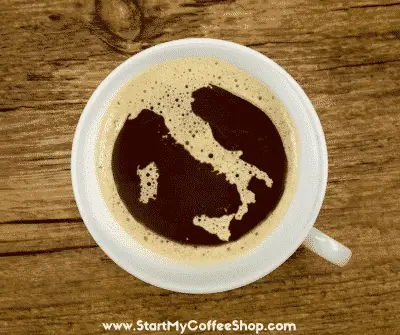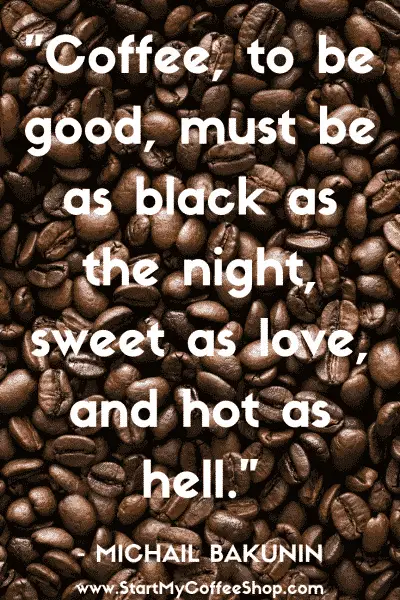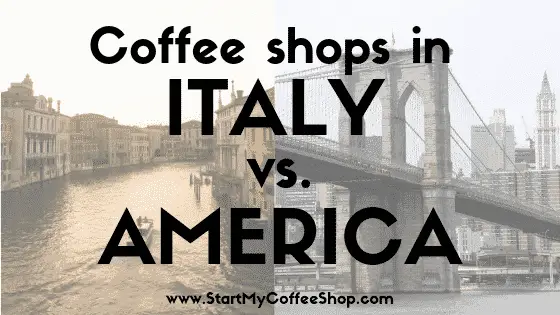Buongiorno! With words like latte, cappuccino, and espresso, there’s no denying that Italians have perfected the art of the brew. Coffee is so much a part of the Italian culture, it’s more like a way of life. In America, coffee is a sweet remedy to get you through the day, battling tiresome mornings, and keeping you caffeinated to conquer life’s duties. We can all agree that coffee is the much-loved beverage, no matter where in the world you’re from. However, there are some differences that take place in coffee shops. This article will explain some of the differences between coffee shops in America and “bars,” as they are referred to, in Italy.

While the same ingredients can be found in coffee shops around the world, there are some major differences that can be seen right away when comparing coffee shops in Italy vs. those in America, from the size of the coffee to the barista preparing it.
- Coffee size – In American coffee shops, the average size of a regular coffee is about 10 oz, with options to upsize all the way to 20 oz, whereas in Italian coffee shops, the average caffé is only 5 oz. If an Italian needs more caffeine after their 5 oz, they order another 5 oz cup.
- Keep it simple – Another difference that any American will spot right away when venturing for coffee in Italy is the menu. Where’s the upside-down Caramel Macchiato? Italians keep their coffee simple without adding extra flavors like Pumpkin Spice to a latte.
- Baristas – Coffee shops in America typically consist of young employees who earn a minimum wage without any concept of how to prepare the perfect coffee. An Italian barista is an artist who enjoys his craft and commits his life to perfecting it, serving the best coffee.
- To stay, or go? – Americans will either take their Joe to go or spend hours curled in the corner of a coffee shop sipping the day away. Italians don’t do either. They make time to order their coffee, down it immediately, and continue on about their day.
- Laptops – With a rise in digital nomads, coffee shops all around America are designed to entice those with a laptop to spend hours working, fueled with caffeine. In Italy, you won’t see anyone buried in their laptop, let alone a sufficient supply of plugs to keep devices charged.
- Prices – Coffee in America is a huge cash crop, which can be seen in the prices they charge for a mediocre tasting, Grade B coffee, while Italians will go out of their way to find the best tasting, Grade A coffee at the cheapest price, offering the best product possible.
- Social activity – As can be seen in popular sayings in America, “Don’t talk to me until I’ve had my coffee”, coffee is mostly enjoyed in solitary peace. Italians treat coffee as a social activity, indulging with friends and family after meals, or to build business relationships.
Regardless of where you are in the world, it’s safe to say a coffee shop is somewhere nearby. What’s important to know is the variance in culture that may accompany. America tends to make products on a more sweet side, thus the concoction of frozen blends and an abundance of flavored syrups to choose from. Italians like their coffee to taste like, well, coffee. The standard coffee served in Italy is an espresso, strong enough to last all day. (More about the ways of American coffee shops can be found here.)

Types of coffee drinks found in Italy
As an American traveling to any foreign country, it’s important to get to know the culture of which you’re going to visit. While one may assume they can walk into a coffee shop anywhere in the world and order their favorite cup of Joe without a problem, it’s best to be familiar with the types of coffee that country may be serving. Here is a list of some traditional drinks that can be found in coffee shops when you explore in Italy.
Caffé – Ordering a normal cup of coffee in Italy is not going to get you the same drip coffee version as seen in American coffee shops. Caffé normale is simply an espresso, served black, and in one-shot increments. Italians love their coffee, but drink it in small, steady doses.
Cappuccino – A classic Italian espresso-based beverage with equal parts espresso, milk foam and steamed milk, topped with just a bit of foam. This classic drink originated in Italy around the 17th century, and is typically served in smaller doses than a similar drink: caffé latte.
Caffé Latte – A caffé latte is similar to the cappuccino, but usually served in larger portions and consists of one part espresso, and two parts steamed milk, topped with foam. The latte is a creamier alternative to the cappuccino, two different drinks, using the same ingredients.
Caffé Macchiato – A caffé macchiato is the closest thing to a standard espresso with cream, which includes an espresso with just a dash of frothy milk. Macchiato translates in Italian to “stained” or “spotted”, making this drink espresso with a spot of milk.
Caffé Americano – Caffé Americano is like the traditional brew seen in American drip coffee. By diluting the espresso with hot water, the strength of the coffee can be determined by the ratio of espresso shots vs. the amount of water that filters through.
Caffé Lungo – The caffé lungo is a way to get a larger coffee without diluting the strength of the espresso as much as with the caffé Americano. A caffé lungo consists of espresso with a dash of hot water, using twice the amount of water as an espresso.
Caffé Corretto – Corretto translates to “corrected”, making this caffé a corrected coffee. It includes one shot of espresso with a small amount of liquor such as grappa, sambuca, or brandy. A barista will either put a few drops of liquor in the espresso, or on the side.
Caffé Freddo – The caffé freddo may be the closest thing you’ll find to a frozen coffee blend. The espresso is either kept in the freezer to make an icy slush, or served shaken with ice and sugar creating a frothy texture: A perfect coffee treat on a warm Italian day.
Ginseng Latte – You won’t find this pleasure in America, but the ginseng latte is gaining much ground for popularity all over coffee shops in Italy. The espresso is combined with ginseng extract, offering wonderful health benefits and added energy.
Traditions and rituals that differ from America in Italian coffee shops
In American coffee shops, culture is far from the mind, unlike what can be found in an Italian coffee shop. Americans would rather have a huge cup of low quality coffee they can nurse all day long. The idea of throwing back several 5 oz cups of espresso all day long doesn’t appeal to the American taste. Italians have made coffee a huge part of their culture, and this can see in several rituals that take place in Italian coffee shops vs. shops in America.
- Time of day – The type of coffee drink consumed in Italy is going to depend on the time of day. Where Americans will enjoy their cappuccino and lattes at any time, caffé lattes and cappuccinos will not be ordered after 11am, and never with a meal. A caffé macchiato may be enjoyed as an afternoon “pick-me-up,” but milky drinks are strictly reserved for the morning.
- To-go – Your order of coffee in Italy is assumed to be “for here” unless specified as a “take away” as called by Italians. The espresso is served at a temperature ready to be consumed immediately, while standing at the bar. Italians don’t typically order their coffee with plans to stay long; otherwise, they will be charged extra for the service of a waiter.
- Payment – It’s customary in Italy to walk into the bar and shout out your order to the barista, even if he has his back to you. Once your coffee is served, you stand and the bar, gulp down the drink and pay after it’s already been consumed. The only time in Italy it will be required to pay before you drink your beverage is at places frequented by tourists such as the airport.
- Grinding beans – American coffee shops will have a vast supply of coffee already ground for the day and will use the pre-grounded coffee the following day if it wasn’t completely used. In Italy, a barista will only grind the required amount of beans a little time in advance based on the day’s moisture level. If they grind too much for the day, it will be thrown out.
- Caffé Pagato – Translated to “paid coffee” it’s a tradition in most Italian coffee shops to keep a separate drawer for money patrons’ pay extra to pay for someone else’s coffee. This means if you’re running low on funds, you can go into most coffee bars in Italy and requesting a caffé pagato, and receive your drink for free. Americans can only imagine…
- Latte – If you go into a coffee shop in Italy requesting a latte, don’t be too surprised when the barista serves you with a simple glass of milk. Latte literally translates to “milk”, so you received exactly what you ordered. If you want the typical drink called latte as it is served in America, be sure to specify you want to order a caffé latte, which includes a shot of espresso.
- Coffee chain – Being such a big cash crop in America, coffee chains are typically seen sprouting all over the nation, taking out the local “mom-and-pop shops”. Italian coffee shops are usually independently owned and have been in the same location for generations. Coffee chains are unheard of in Italy; the first Starbucks was finally opened after 48 years. (By the way, franchising a coffee shop may be easier than you thought. Click here to find out how.)
The process to brew coffee in Italy is much more curated than seen in American coffee shops. Americans ordinarily prefer drip coffee to the espresso, which is preferred in most of the rest of the world. Coffee to an American is summed up as a spoonful of instant coffee added to hot water. It’s then drowned in flavored syrups and doesn’t have to resemble the natural flavor of coffee. The aim of Italians is to create a strong, high-quality coffee that actually tastes like coffee. Oftentimes a barista will serve you coffee with a glass of water to clean your mouth from other flavors, so you can truly enjoy the perfectly brewed flavor.

“Il caffé, per esser buono, deve essere nero come la notte, dolce come l’amore e caldo come l’inferno.” Michail Bakunin (1814 – 1876)
Clearly, Italians take their coffee a bit more seriously than can be seen in America. Nonetheless, we all love our savory indulgence that the espresso bean can bring. No matter if we enjoy it mixed with steamed milk, day or night, or if we love the strong bold flavor served at the perfect temperature in tiny cups made of china, coffee is the ultimate source of pleasure bringing joy to people worldwide. La vita inizia dopo il caffé: life begins after coffee.
Frequently Asked Questions
Lavazza is the number one coffee available in Italy and has been in top rank in Italy for over 120 years. Staying true to their local roots, Lavazza has maintained its value and integrity, building a global empire, currently ranking as the third-largest coffee brand worldwide, mastering the art of coffee, as well as the art of business.
The biggest difference can be seen right away between regular American drip coffee and espresso is the fineness of the coffee grinds. What isn’t easily seen is drip coffee actually has more caffeine than espresso. Finally, the difference is in flavor, as espresso tastes much stronger than regular drip coffee.
To learn more on how to start your own coffee shop checkout my startup documents here
Please note: This blog post is for educational purposes only and does not constitute legal advice. Please consult a legal expert to address your specific needs.

Hi! I’m Shawn Chun
My adventure in coffee began when I first launched my first coffee shop back in the early 2000s. I had to figure out so many things on my own and to make it worse within 2 years of opening two large corporate coffee chains moved in just blocks away from me!
As I saw smaller and even some larger coffee shops in the neighborhood slowly lose customers to these giant coffee chains and slowly close up shop, I knew that I had to start getting creative…or go out of business.
I (like you may be) knew the coffee industry well. I could make the best latte art around and the foam on my caps was the fluffiest you have ever seen. I even had the best state-of-the-art 2 group digital Nuova Simonelli machine money could buy. But I knew that these things alone would not be enough to lure customers away from the name brand established coffee shops.
Eventually, through lots of trial and error as well as perseverance and creativity I did find a way to not only survive but also thrive in the coffee/espresso industry even while those corporate coffee chains stayed put. During those years I learned to adapt and always faced new challenges. It was not always easy, however, in the end, I was the sole survivor independent coffee shop within a 10-mile radius of my location. Just two corporate coffee chains and I were left after that year. All told the corporate coffee chains took down over 15 small independent coffee shops and kiosks and I was the last one standing and thriving.
Along the years I meet others with the same passion for coffee and I quickly learned that it is not only “how good a barista is” that makes a coffee shop successful, but the business side of coffee as well.
Hence why I started this website you are on now. To provide the tools and resources for up and coming coffee shop owners to gain that vital insight and knowledge on how to start a coffee shop successfully.
Stick around, browse through my helpful blog and resources and enjoy your stay! With lots of LATTE LOVE!
Shawn








